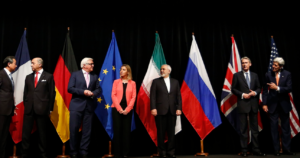July 15, 2020, marks the fifth anniversary of the Iranian regime’s nuclear deal with 5+1 countries, a deal woven through with appeasement policy, leading to nothing but instability in the region and the spread of terrorism. During the first three years, from 2015 to 2018, the Iranian regime’s proxy groups continued to be developed unchecked, in the regime’s hands turning into an apparatus for the killing of Iraqis, Yemenis and the people of Lebanon. The deal also enabled the regime to support Bashar al-Assad’s dictatorship in Syria, giving it an open hand in chemically bombing its own people. The Assad regime’s war against the Syrian people with the help of Qasim Soleimani, the late chief of the Qods force, led to five million Syrian refugees. No wonder Mohammad Javad Zarif, the Iranian regime’s foreign minister, called this deal his greatest diplomatic achievement. Speaking in Majlis (parliament) he said: “I met each week with Qasim Soleimani and we set our schedules together.” Also, Hassan Rouhani called the deal the key to solving Iran’s economic problems. But after five years, the JCPOA has borne no fruit, but rather catastrophe for the regime.

The outraged people of Iran shook the foundations of the clerical rule with three great uprisings in 2017, 2018 and 2019. After each uprising the regime claimed to have everything under control, yet again the brave youth of Iran,
accompanied by all strata of the society, rose in another uprising; even more widespread, to show their abhorrence of this regime. Eventually, on Tuesday, May 8, 2018 the US left the JCPOA and President Donald Trump ordered the revival of the sanctions against the Iranian regime.
Irrevocable developments have taken place during 2018 to 2020, in the region and regarding Iran’s internal affairs. Qasem Soleimani, the number one terrorist and the chief of the IRGC’s (Islamic Revolutionary Guards Corps) Quds Force was killed; in Soleimani, the Iranian regime lost one of its most important commanders who coordinated its regional terrorism and his death has resulted in debilitating the regime’s proxies in the region. Also during the last two years, Tehran has faced serious economic, social and political crises; its ruling elite witnessing serious internal fractures. As far as its economy is concerned, according to a report published by ‘Trading Economist’ on July 2, 2020, Iran’s annual inflation rate reached 22.5% in June of 2020; food and beverages had seen a 14.9% rise, housing, and services 21.7%, transportation 48.6%, medical and hygienic services 24%, clothing and shoes 28% and restaurants and hotels a 17.9% rise in prices.
In a Bushehr’s City Council meeting on Tuesday, July 14, Majid Khorshidi security and social deputy of Bushehr’s (southeast Iran) governor said: “Sanctions have crippled our economy.” (Avaye-Bushehr- July 15, 2020) He continued: “Impacted by escalating sanctions, and with the coronavirus increasing the impact, the country’s economy is in turmoil.” He spoke of “a halt in all” the regime’s “revenues.”
Recently, the minister of Health and Medical Education, Saeed Namaki, stated: “Having in mind the conditions of our citizen’s livelihood, we must think of all the poor, rioting.” (Deutsche Welle- July 9, 2020).
The regime’s Supreme Leader, Ali Khamenei, is well aware of the army of hungry people and knows that the slightest mishap could ignite a great uprising. To control this situation, Khamenei has seized control over political, economic and cultural affairs, unilaterally controlling the society. He has engineered a homogeneous governing force, putting Ibrahim Raisi and Mohammad Baqer Qalibah over two of the country’s powers, the judicial and the executive, and trying to seize the third one too, the legislative, by an effort to oust Rouhani and replace him with one of his own ‘royal pawns’, to help save himself from the current infighting. Khamenei and his faction are turning Rouhani into a scapegoat, blaming all the regime’s failed policies on him to relieve Khamenei of the blame. Regime MPs (appointed by Khamenei in a sham election) signed for Rouhani’s impeachment. But Khamenei, not having the power to exclude Rouhani from their infighting, is holding back the reins. This is the dead-end that Khamenei is facing in trying to homogenize his ruling force.
Meanwhile, in the early hours of Thursday, July 16, a huge crowd, led by youths, took to the streets in Behbahan (located in Khuzistan Province, southwestern Iran). They gathered in front of the Meli Bank which was torched in November 2019 uprising and chanted: “Don’t be afraid, we are all together”, “canon, tanks and fire crackers, the mullahs must get lost” and “neither Gaza nor Lebanon, I give my life for Iran.”
In a short time, in fear of a rise in other cities, the regime disrupted and cut the internet in Khuzistan Province.
SSF units (Social Security Forces) were deployed to the scene and tried to disperse the crowd by firing tear gas canisters and shooting in the air, but the youths confronted them in the streets and alleys by throwing stones at them.
The chief of Behbahan’s SSF, Colonel Mohammad Azizi, announced the day after that the protesters “not only didn’t disperse” when police entered the scene, “but also started chanting slogans against the Nezam (system)”.
Simultaneously, Iranians abroad, along with advocates of democracy in Iran, held a global webinar gathering with live communication from 30,000 locations in more than a 100 countries of the world in solidarity with the Iranian people. A thousand political personalities from many countries participated in this global gathering, several making speeches pledging their support.
This comprehensive portrait of the current political situation shows that the regime in Iran is tangled in a political and economic dead-end, with no light for it at the end of the tunnel.
Hassan Mahmoudi, social analyst, a researcher is an independent observer and commentator of Middle Eastern and Iran.tweets @hassan_mahmou1
